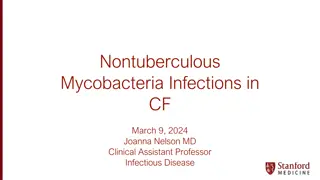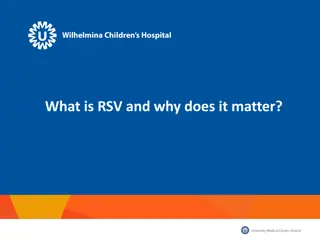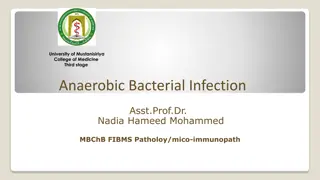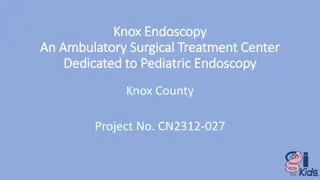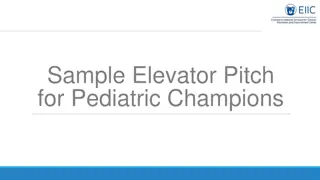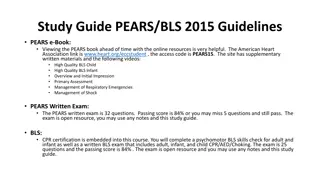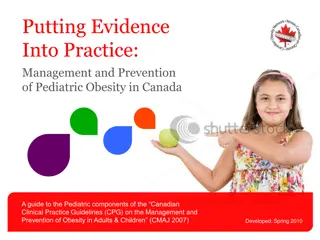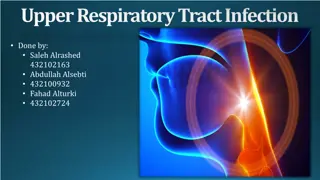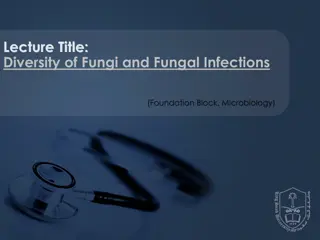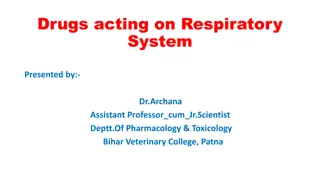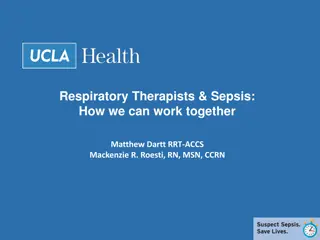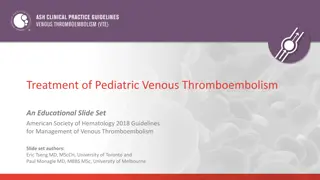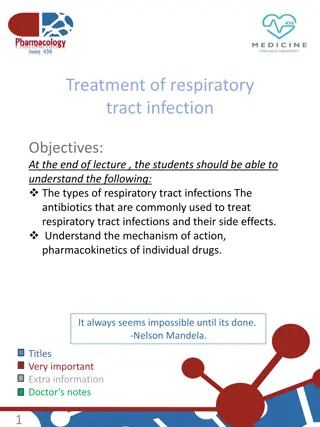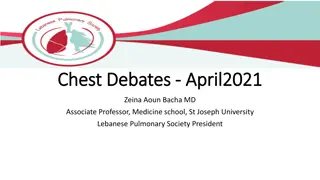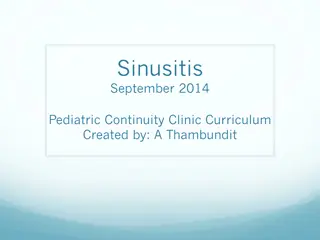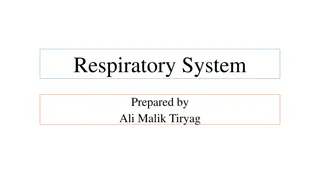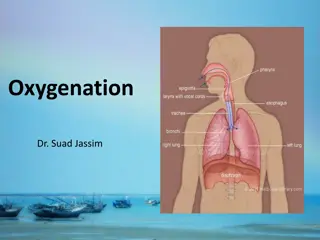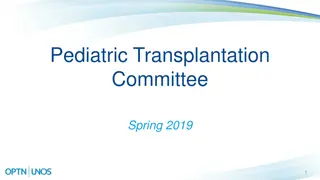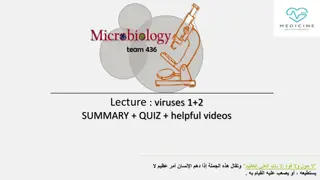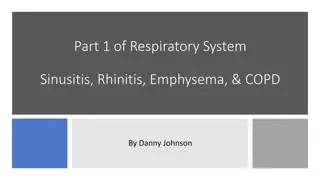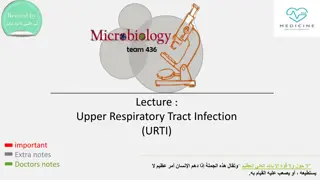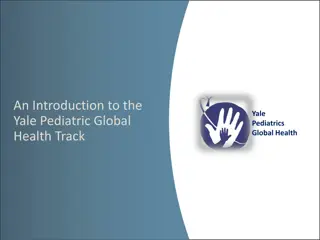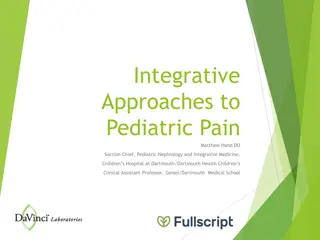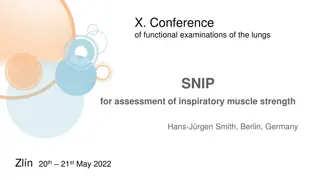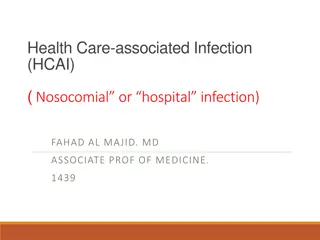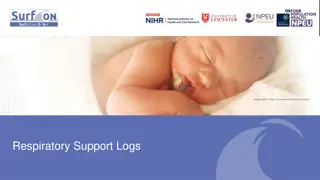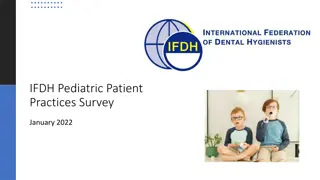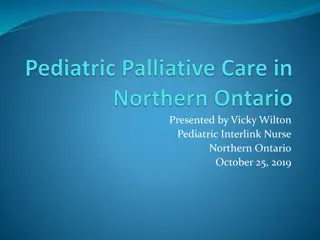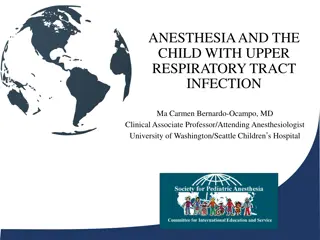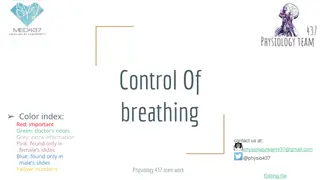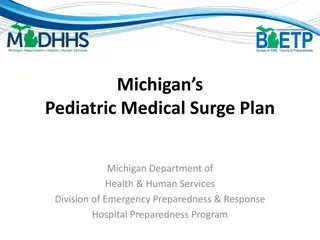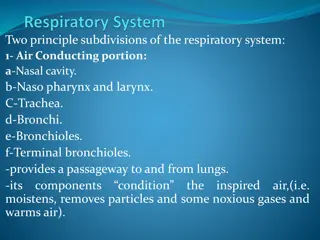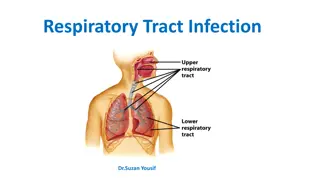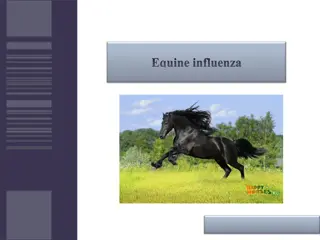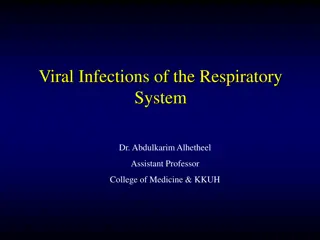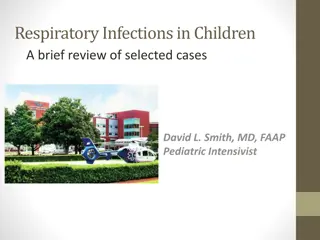Pediatric Workforce Initiative 2025 Presentation Highlights
Explore the key points of the Pediatrics 2025 AMSPDC Workforce Initiative, emphasizing the importance of investing in pediatric health care, the role of pediatric subspecialists, and the need for improved access to specialized care for children and adolescents. The presentation covers reasons to pri
2 views • 28 slides
Understanding Nontuberculous Mycobacteria Infections in Cystic Fibrosis
Nontuberculous mycobacteria (NTM) infections present a significant challenge in individuals with cystic fibrosis (CF). These infections are caused by over 200 species of atypical mycobacteria found in various environments. The CF-ID Clinic plays a crucial role in managing patients with multi-drug re
2 views • 25 slides
Pediatric Trauma Resources: Chest, Abdomen, and Pelvis Review
This guideline provides resources for the evaluation and management of chest, abdomen, and pelvic trauma in pediatric patients. It covers a range of topics including thoracic injuries, abdominal trauma evaluation, nonoperative management protocols, and guidelines for various pediatric injuries. The
4 views • 21 slides
Understanding RSV and its Global Impact
RSV, or respiratory syncytial virus, is a significant global health concern causing severe respiratory infections, particularly affecting young children. It leads to pediatric hospitalizations and mortality, with a high burden in low- and middle-income countries. Prevention strategies, such as long-
7 views • 23 slides
Trusted Partner in Pediatric Wellness is Our QuickMD Care - Google Docs
Quickmdcare-Pediatrician Doctors provides a wide range of Pediatric services in Pediatric hospital at Frisco, Mckinney, Texas. Pediatric Doctors Clinic.
6 views • 1 slides
Anaerobic Bacterial Infections: Overview and Clinical Implications
Anaerobic bacterial infections are caused by bacteria that do not require oxygen for growth, posing challenges in diagnosis and treatment. This article delves into the types of anaerobic bacteria, their role in human infections, and common clinical presentations such as abscess formation. Gram-negat
1 views • 24 slides
Enhancing Pediatric Endoscopy Services at Knox County
Knox Endoscopy, dedicated to pediatric endoscopy, faces a growing caseload demanding additional capacity. Existing facilities are at optimal utilization levels, prompting the proposal of a cost-effective Ambulatory Surgical Treatment Center (ASTC). The proposed ASTC is expected to be a more efficien
0 views • 9 slides
Elevator Pitch for Pediatric Champions
Elevator speech helps in defining and communicating the value proposition of a project efficiently. In the context of developing a pediatric champion role, this pitch emphasizes the significance of having a dedicated staff member focused on pediatric readiness, highlighting the need for improved pra
0 views • 5 slides
Pediatric Emergency Assessment and Resuscitation Study Guide
Study Guide for PEARS/BLS 2015 Guidelines covers key topics such as initial assessment, pediatric respiratory emergencies, shock management, and CPR certification. Access online resources and videos for better preparation. Learn about PEARS systematic approach algorithm, hypotensive shock criteria,
0 views • 9 slides
Pediatric Obesity Management and Prevention Guidelines in Canada
This resource provides guidance on pediatric obesity management and prevention in Canada, based on the Canadian Clinical Practice Guidelines. It includes recommendations specific to the pediatric population, implementation strategies, and insights from content experts. The slides cover a range of to
1 views • 66 slides
Differentiating between Viral and Bacterial Infections in Upper Respiratory Tract
Understanding the distinction between viral and bacterial upper respiratory tract infections is crucial for effective management and treatment. This article discusses key differences in symptoms, diagnostic methods, and treatment approaches to aid in accurate differentiation between the two types of
2 views • 87 slides
Understanding Fungi Diversity and Infections in Microbiology
Explore the world of fungi and fungal infections in this foundation block of microbiology. Learn about medically important yeasts, mold fungi, major fungal diseases, antifungal agents, and infection acquisition methods. Dive into hypersensitivity reactions, mycotoxicoses, and various types of fungal
1 views • 19 slides
Understanding Drugs Acting on the Respiratory System for Effective Treatment
Explore the classification and actions of drugs targeting the respiratory system, including antitussives, expectorants, respiratory stimulants, bronchodilators, and mucolytics. Discover how these medications work to suppress coughs, promote fluidity of bronchial secretions, and stimulate respiratory
0 views • 14 slides
Collaborating to Combat Sepsis: Role of Respiratory Therapists
Sepsis is a critical condition involving infection and inflammation, where the body's response causes widespread symptoms. Learn about the continuum of sepsis, its pathophysiology, and respiratory warning signs. Respiratory therapists play a crucial role in identifying and managing sepsis, with stat
1 views • 14 slides
Guidelines for Management of Pediatric Venous Thromboembolism
This educational slide set presents the American Society of Hematology's 2018 guidelines for the treatment of pediatric venous thromboembolism. The guidelines cover various aspects such as prevention, treatment, and optimal management of anticoagulation therapy in pediatric patients. Panels were for
0 views • 47 slides
Understanding the Treatment of Respiratory Tract Infections: Antibiotics and Management
This lecture covers the classification of respiratory tract infections and the antibiotics commonly used to treat them. It highlights the types of infections caused by viruses and bacteria, along with their respective treatments. The mechanism of action and pharmacokinetics of antibiotics, such as p
0 views • 7 slides
Understanding Acute Respiratory Infections (ARI): Symptoms, Classification, and Transmission
Acute Respiratory Infections (ARI), characterized by sudden onset respiratory symptoms affecting the respiratory system from nose to alveoli, are a complex group of diseases caused by various agents. Symptoms include pain in the sinuses, nasal congestion, fatigue, sinusitis, coughing, and more. The
0 views • 16 slides
Respiratory Health Insights and Updates by Dr. Zeina Aoun Bacha, MD
Explore key topics in respiratory health with Dr. Zeina Aoun Bacha, MD, including World Respiratory Diseases Day, Organizing Pneumonia, Sputnik Five Vaccine, and AstraZeneca Vaccine. Stay informed on important respiratory events and vaccination developments.
1 views • 10 slides
Pediatric Sinusitis Curriculum and Clinical Cases
This content focuses on sinusitis in pediatric patients, covering topics such as clinical criteria for diagnosis, pathophysiology, complications, treatment options, and current guidelines. It includes case studies involving common symptoms like rhinorrhea, cough, and decreased energy levels, highlig
0 views • 23 slides
Understanding the Respiratory System: An Overview
The respiratory system, consisting of the upper and lower respiratory tracts, is responsible for ventilation and gas exchange. Learn about the anatomy, common symptoms like dyspnea and cough, and how the system functions anatomically and physiologically. Understanding these aspects can help in recog
0 views • 15 slides
Understanding Oxygenation and Respiratory System Function
Explore essential terms like alveoli, perfusion, atelectasis, and more in the context of respiratory system function. Learn about lung anatomy, oxygenation processes, and common respiratory disorders like dyspnea and hypoxia. Discover the crucial factors for maintaining normal respiratory function.
0 views • 35 slides
Pioneering Pediatric Transplantation Initiatives
In the realm of pediatric transplantation, recent projects and upcoming bylaw implementations are focused on enhancing care transition, establishing key personnel requirements, and implementing vital components for kidney, liver, heart, lung, and pancreas transplants. The initiatives aim to improve
0 views • 9 slides
Viral Infections of the Respiratory System Lecture Summary & Quiz
This lecture covers viral infections of the respiratory system, focusing on Avian flu, Influenza Virus, Respiratory Syncytial Virus, Human metapneumovirus, Parainfluenza viruses, Measles, and Mumps virus. It includes information on the structure, symptoms, lab diagnosis, treatment, and prevention of
0 views • 11 slides
Understanding Respiratory System Disorders: Sinusitis, Rhinitis, Emphysema, and COPD
This informative content delves into common respiratory issues such as sinusitis, rhinitis, emphysema, and COPD. It provides detailed information on the symptoms, diagnostic criteria, and rating formulas for each condition. The content also touches upon military service-related respiratory problems.
0 views • 15 slides
Understanding Upper Respiratory Tract Infections (URTI) in Children
This informative lecture covers the epidemiology, clinical presentations, common etiological agents, and laboratory diagnosis of upper respiratory tract infections (URTI) in children. Topics discussed include pharyngitis, diphtheria, epiglottitis, pertussis, acute otitis media, sinusitis, and other
0 views • 16 slides
Yale Pediatric Global Health Track Overview
The Yale Pediatric Global Health Track aims to equip pediatric residents with the skills and understanding necessary to address child health inequities globally. Residents gain exposure to core health disparity principles, ethical global health principles, and major causes of childhood morbidity. Th
0 views • 13 slides
Integrative Approaches to Pediatric Pain Management: A Comprehensive Review
Pediatric pain management is a complex issue involving factors such as inflammation, neuroplasticity, and emotional responses. Dr. Matthew Hand explores integrative approaches to address common pediatric pain conditions and highlights the prevalence of chronic pain in children. The presentation delv
0 views • 39 slides
Sniff Nasal Inspiratory Pressure (SNIP): Assessing Respiratory Muscle Strength
SNIP is a sensitive non-invasive test that measures inspiratory muscle strength by assessing nasal pressures during a sniff maneuver. It is a valuable tool for early detection of respiratory muscle decline, providing insights into potential threats like hypercapnic respiratory failure, impaired coug
0 views • 11 slides
Understanding Health Care-associated Infections (HCAI) in Hospital Settings
Health care-associated infections (HCAI), also known as nosocomial or hospital infections, are infections that occur in patients during their hospital stay or after discharge. These infections can result from various sources, including colonization by microorganisms and exposure to contaminated envi
0 views • 48 slides
Neonatal Respiratory Support Study Overview
This study focuses on evaluating the primary outcomes of length of hospital stay post-birth and incidence of severe respiratory failure in infants receiving respiratory support. Detailed logs are maintained daily until the infant is off respiratory support or discharged. The study is funded by NIHR.
0 views • 19 slides
IFDH Pediatric Patient Practices Survey January 2022
Survey conducted by IFDH in January 2022 to understand the practices of dental hygienists with pediatric patients aged 6 to 12. The survey gathered responses from 367 participants across 25 countries, with a focus on demographics, work settings, educational backgrounds, and frequency of seeing pedia
0 views • 19 slides
Pediatric Palliative Care and the Role of Interlink Nurses in Northern Ontario
Vicky Wilton, a Pediatric Interlink Nurse in Northern Ontario, presented on pediatric palliative care focusing on identifying differences and similarities between pediatric and adult care, integrating advance care planning, and emphasizing hope. The role of Pediatric Interlink Nurses within the Pedi
0 views • 69 slides
Anesthesia and Upper Respiratory Tract Infections in Children
This presentation discusses the etiology, differential diagnoses, and management of upper respiratory tract infections (URIs) in children undergoing anesthesia. It covers causes of bronchoconstriction, adverse respiratory effects of URIs, and current anesthetic recommendations. The content emphasize
0 views • 52 slides
Understanding the Control of Breathing and Respiratory Rhythm
The content delves into the intricacies of the control of breathing, emphasizing the role of the medulla oblongata in regulating respiratory activity. It explores factors modifying breathing patterns, respiratory consequences of changing PO2, PCO2, and pH, and the functions of central and peripheral
0 views • 16 slides
Michigan Pediatric Medical Surge Plan Overview
The Michigan Statewide Pediatric Steering Committee has developed a framework for the Pediatric Medical Surge Plan, with ongoing work needed for review and updates. The plan aims to guide medical care provision for children during disasters, involving various stakeholders and following defined traum
0 views • 18 slides
Understanding the Respiratory System Components and Functions
The respiratory system consists of two primary subdivisions: the Air Conducting portion and the Respiratory portion. The Air Conducting portion includes nasal cavity, naso-pharynx, larynx, trachea, bronchi, bronchioles, and terminal bronchioles, providing a pathway to and from the lungs while condit
0 views • 12 slides
Understanding Respiratory Tract Infections: Causes and Prevention
Respiratory tract infections are commonly caused by viruses, bacteria, rickettsia, and fungi, leading to various health issues. These infections can be transmitted through droplets, droplet nuclei, and dust, emphasizing the importance of maintaining respiratory health through specific and non-specif
0 views • 34 slides
Understanding Equine Influenza: An Overview of Respiratory Tract Infections in Horses
Equine influenza is a contagious upper respiratory infection in horses caused by influenza viruses. This article covers the anatomy of the equine respiratory tract, signs, diagnosis, treatment, prevention, and prognosis of equine influenza. It also discusses the histological structure of the respira
0 views • 18 slides
Understanding Viral Infections of the Respiratory System
Respiratory viral infections are common and primarily caused by viruses, leading to morbidity and time off work. They can range from mild upper respiratory tract infections to severe lower respiratory tract infections like pneumonia. Various viruses like influenza, parainfluenza, respiratory syncyti
0 views • 23 slides
Pediatric Respiratory Infections: An Overview of Cases and Physiology
This review delves into selected cases of respiratory infections in children presented by Dr. David L. Smith, focusing on the anatomical and physiological aspects of the pediatric airway and respiratory system. It discusses respiratory failure in infants and small children, metabolic demands, cyanos
0 views • 49 slides

